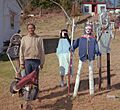George Paul Kornegay facts for kids
George Paul Kornegay (born November 23, 1913 – died June 3, 2014) was a special kind of American artist. He made what's called "folk art" or "outsider art." This means he created art outside of traditional art schools. He was also a minister in the African Methodist Episcopal Zion Church. Kornegay built a huge Christian art display using everyday items he found. This amazing art space was located near Brent, Alabama.
Early Life and Work
George Kornegay was born on November 23, 1913, in Bibb County, Alabama. He was the second of ten children. His father worked as a farmer, miner, and made barrels. His mother took care of the children.
George went to the Alabama Mission School in Brent. He studied there until the tenth grade. But he had to leave school to help his father. They worked together in sharecropping, which meant they farmed land owned by someone else.
Later, his father bought 28 acres of land. This land was near Brent, Alabama. He also bought a two-story house from a Cherokee man named Charles Hogan. The cost was $100. This property was on an old Native American burial ground. George Kornegay once said that his daughter could "hear voices out here talking." He also felt it was a "sacred place" where people could feel better.
Kornegay worked at a steel mill called Century Foundry. This mill was in Tuscaloosa. He worked many different jobs to support his family. He said he went "from a plow to a preacher, from a preacher to a steel mill." He also worked at a veneer mill, a cotton sack, a saw mill, and a paper mill. He worked double shifts to make a living for his family.
Family and Religious Calling
George Kornegay married Minnie Sue Tubbs on August 9, 1932. They had a large family with 12 children. They had eight boys: Arthur Paul, George Jr., Earvin, Arthur Lee, Joel, Benjamin, Donald, and Ronnie. They also had four girls: Gloria Jean, Dorothy, Donna, and Annie.
George felt a "divine calling" to become a minister. This means he felt God was asking him to preach. At first, he was scared. But he said God kept pushing him. He asked God for signs to show this was his path. He believed God sent him these signs. He even said a "choir of angels" visited his house.
Kornegay served for many years as a minister. He was part of the African Methodist Episcopal Zion Church. People lovingly called him "Big Daddy." He preached in churches like Grove Hill, Cottage Hill, and Marietta. He served these churches for over fifty years.
Creating His Art Mountain
In 1960, Kornegay started building a huge art project. It was like a story told through art. This "visionary environment" was on a two-acre hill near his home. He used paintings, sculptures, and objects he found. He worked on it full-time after he retired in 1980.
Kornegay gave his art space several names. These included The New Jerusalem, Seven Holy Mountains, Art Hill, and the Sacred Mountain.
He was inspired to create this art after a dream. In the dream, God told him that art would help him share his religious messages better. Kornegay first planned to sculpt a face on a red rock. But he felt he was told not to. Instead, he heard a message: "Upon this rock I'll build my church." This was the start of his amazing art project.
He only meant to sculpt the rock. But God told him to "Go further." Kornegay asked God how to do this each morning. The next day, he felt he had to "Put a piece here, put a piece there." He was told to "never throw nothing away." He believed God gave him the vision to see where everything belonged. He said, "I can see more with my eyes closed than they can see with my eyes open." He used this gift until he died.
Kornegay's art showed many themes. These included his Native American family history. He also included African traditions. His art also featured Christian visions and Bible stories. Examples include the Last Supper and scenes of crucifixions. His African heritage was seen in his bottle trees. These were objects that looked like spiritual Nkisi.
William Arnett interviewed Kornegay in 1997 and 1998. Arnett worked for the Souls Grown Deep Foundation. They made an agreement that Kornegay's art would stay where it was. This is called keeping art in situ. It meant he would not sell it to collectors. Arnett took photos of the art before it was later spread out.
George Kornegay lived to be over 100 years old. He passed away on June 3, 2014. His wife and his daughter Donna Lee had passed away before him. He was survived by his 11 children, 30 grandchildren, and 45 great-grandchildren.
Images for kids



